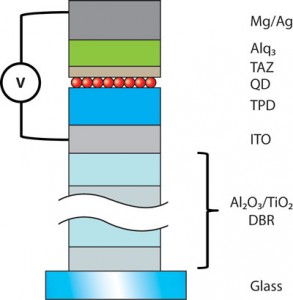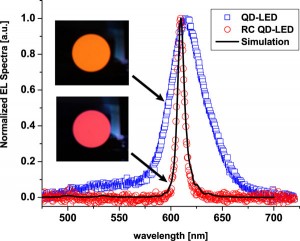Resonant Cavity Effect on Colloidal Quantum-dot Light Emitting Diodes: An Experimental and Theoretical Study
- Category: Electronic Devices
- Tags: Vladimir Bulovic, Yasuhiro Shirasaki
Colloidal quantum dots (QDs) are semiconductor nanoparticles that can be used in monolayers in low operating-voltage, non-lithographically fabricated, thin film LEDs exhibiting narrow-band emission [1] . Applications such as optical communication, spectroscopy, and sensing could benefit greatly from thin film devices that offer near-monochromatic, directed, and intense emission. The goal of our project is to demonstrate the feasibility of such devices by integrating a QD-LED into a planar resonant cavity (RC), akin to previous reports of RC structures [2] [3] , to enhance the intensity, directionality, and monochromaticity of the QD electroluminescence (EL).
The RC structure that we investigate (Figure 1) consists of a standard QD-LED [4] grown on top of a distributed Bragg reflector (DBR). An 8-pair DBR with an average reflectivity of 98 % between wavelengths of 575 nm and 625 nm is used to investigate the RC effect on a QD-LED. With this structure, we achieve a narrowed emission spectrum, which is evident when comparing spectra and photographs of the QD-LED and the RC QD-LED EL (Figure 2). The full width half maximum of the EL spectrum is reduced from 40 nm to 8 nm upon addition of the cavity.
To corroborate our experimental findings and to optimize the design of an RC QD-LED, we simulated the effect of the RC on the EL of the QD film. We first calculate the enhancement or suppression of the electric field at the location of the QD film for different wavelengths and different angles and then use Fermi’s golden rule to determine the transition rates for each of these conditions. As shown in Figure 2, the simulation is in good agreement with the experimental result, suggesting that the effect we observe is indeed an RC effect.
- Figure 1: Schematic of RC QD-LED.
- Figure 2: Comparison of EL spectra and photographs of RC QD-LED and QD-LED. The RC QD-LED exhibits marked spectral narrowing compared to the QD-LED.
- S. Coe, W. K. Woo, M. Bawendi, and V. Bulović, “Electroluminescence from single monolayers of nanocrystals in molecular organic devices,” Nature, vol. 420, pp. 800-803, Dec. 2002. [↩]
- E. M. Purcell, “Spontaneous emission probabilities at radio frequencies,” Physical Review, vol. 69, pp. 681, Jun. 1946. [↩]
- E. F. Schubert, N. E. J. Hunt, M. Micovic, R. J. Malik, D. L. Sivco, A. Y. Cho, and G. J. Zydzik, “Highly efficient light-emitting diodes with microcavities,” Science, vol. 265, pp. 943-945, Aug. 1994. [↩]
- C. Wilmsen, H. Temkin, and L. Coldren, Vertical Cavity Surface Emitting Laser, Cambridge: Cambridge University Press, 1999. [↩]

